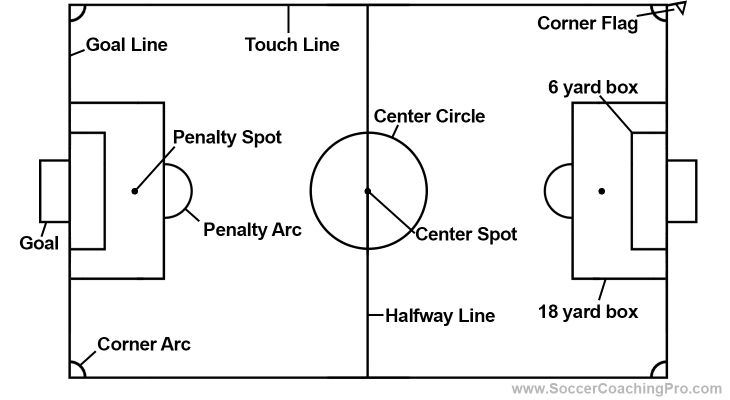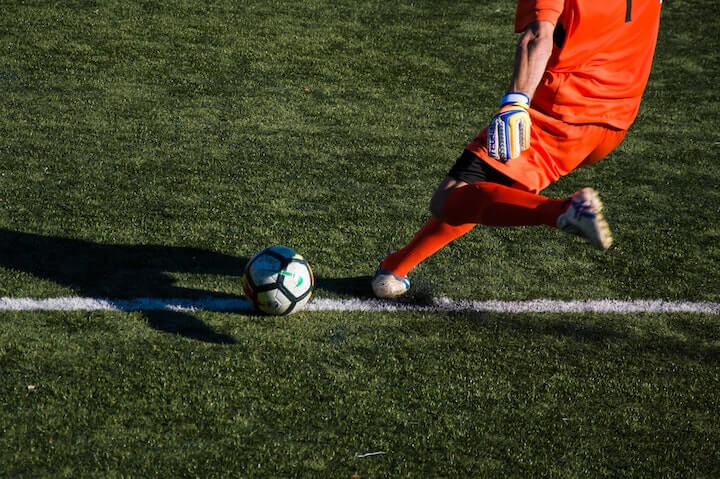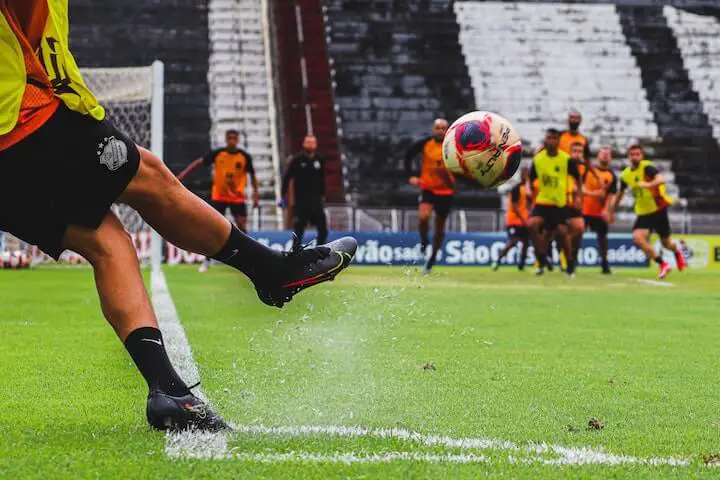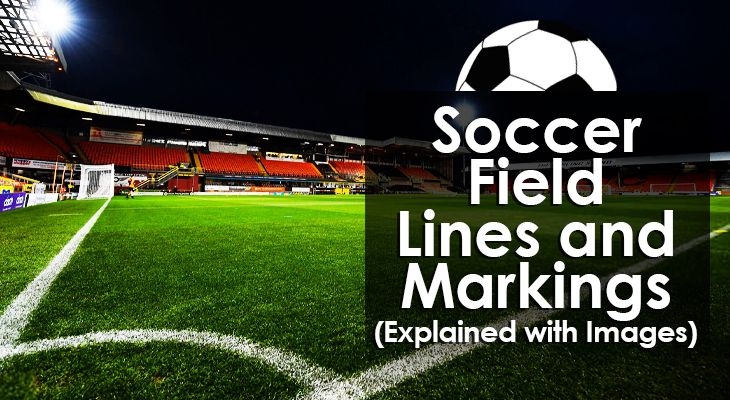Soccer Field Lines and Markings (Explained with Images)
Soccer is played on a large rectangular field, often called a "pitch".
The specific dimensions of the soccer field vary depending on the competition level, number of players, and the laws governing the league.
Once players begin participating in 11v11 competitions, the governing leagues mandate that all fields fall in line with the official guidelines.
Understanding soccer field lines and markings is not only important for players, but it’s also essential for coaches, parents, and referees.
It ensures they know what space is available and how they should set their team up positionally.
Soccer Field Lines (Image)

Learning the many soccer field lines and markings involves far more than simply recognizing the length and width of the playing surface.
There are also several other important features to consider, including the corner area, penalty box, center circle, and technical area.
Failing to understand what the lines represent can cost your team dearly, especially when it comes to the out-of-bounds rules and fouls inside the box.
Soccer Field Perimeter
Two touchlines and two goal lines mark the perimeter of the field or pitch.
Touchlines run the length of the field and must be longer than the goal lines.
Goal lines mark the end of the playing area and run across the pitch.
The goal posts should be at the center point of each goal line.
Touchline / Sideline
According to IFAB, the touchline should measure:
> Min. length of 100 yards (90 m)
> Max. length of 130 yards (120 m)
If the ball crosses the touchline, the referee awards a throw-in against the team that last touched the ball.

Goal Line / End Line
Goal lines or end lines must measure:
> Min. width of 50 yards (45 m)
> Max. width of 100 yards (90 m)
International Games
For international games and tournaments, like the FIFA World Cup, IFAB outlines more stringent guidelines.
The length of the touchline must be:
> Min. length of 110 yards (100 m)
> Max. length of 120 yards (110 m)
The goal line must be:
> Min. width of 70 yards (64 m)
> Max. width of 80 yards (75 m)
Halfway Markings
A soccer field is divided into two halves, marked by the halfway line.
This line stretches across the width of the pitch and connects the halfway points of each touchline. Therefore it’s the same width as and parallel to the end lines.
In any game, each team gets assigned a half to defend (this switches after half-time).
Players must remain within their half of the field before kick-offs or restarts (e.g. after a goal, after half-time, or before extra time is kicked off).
During a penalty shootout, both teams (excluding the goalkeeper and kicker) line up along the halfway line.

Soccer Field Markings
a. Center Circle
The center circle is a mark in the middle of the field, that falls equally into each half.
It must have a radius of 10 yards (9.15 m).
This marking indicates the minimum distance the opposing team must maintain during kickoff.
b. Center Mark
The exact center of the field is marked with a small (approximately ball-sized) white circle to indicate where the ball should be kicked off.
c. Penalty Area
Penalty areas are extremely important sections of a soccer pitch.
There are two on every field: one on each end that connects with the end lines.
If a player commits a foul inside their own (defending) penalty area, the opposing team gets a penalty kick. Regardless of the field’s overall dimensions, penalty boxes are uniform in size.
d. Penalty Box
Each penalty box is rectangular in shape and must be 18 yards (16.5 m) long and 36 yards (32.9 m) wide.
It's important to now that ehe lines that mark the box are part of the penalty area.
e. Goal Area
The goal area, often referred to as the 6-yard box, is a small rectangle around the goal frame.
Goalkeepers can take goal kicks from anywhere inside this box which measures 6 yards (5.5 m) long and 20 yards (18.3 m) wide.
f. Penalty Spot
The penalty spot indicates where players take penalty kicks from.
This spot is 12 yards from the center of the goal, marked by a white circle (like the kick-off spot).
g. Penalty Arc
You may have noticed the small arc on the edge of each penalty area.
Although the circle doesn’t continue inside the penalty box, it should have a radius of 10 yards (9.15 m) from the penalty spot.
Players cannot enter the arc during penalties. However, it isn't considered part of the penalty area so a foul within the arc results in a free kick rather than a penalty.
h. Corner Area
The corner area is a quarter circle and marks the space where players can place the ball during a corner kick.
The quarter circle has a radius of 1 yard (1 m) with the corner of the field acting as the center point.

Other Important Measures
There are several other important measurements and markings on a soccer pitch, such as:
Goal posts: 8 yards (7.32 m) wide and 2.67 yards (2.44 m) high.
Corner flags: 1.64 yards (1.5 m) high
Technical area: extends a maximum of 1 yard (1 m) on either side of the bench and up to 1 yard (1 m) from the touchline
Soccer Field Lines Vs Other Sports
Soccer field lines work a little differently from play area lines in other sports, like basketball or American football.
The key differentiator in soccer is that leagues consider the lines on the field as part of the section they define.
This means that the sideline or touchline remains part of the field.
If the ball is on or above these lines, it's still considered to be in-bounds.
In other words, the ball isn’t deemed out of play unless it crosses the line entirely.
Therefore, the ball must be fully over the end line or goal line for goal to be awarded.
Likewise, the penalty box lines are also considered part of the penalty box. So if a player is fouled on the line, referees award them with a penalty.
Another important consideration:
A player can be technically off the field of play while in possession of the ball, but as long as the ball is still on the pitch, the game continues as normal.
This is totally different from basketball or American Football -- where players are considered out of bounds as soon as their toe, or any part of their body, hits the line.
Soccer Fields Can Be of Different Sizes
The final feature that makes soccer field lines unique is that they aren't always uniform in size.
According to IFAB, the measurements of an 11v11 field must fall within certain parameters.
The reason for this flexibility is to allow clubs to build their home grounds in accordance with their needs and financial situation.
However, certain bodies, like the MLS or the English F.A. may set their own standards, which may or may not be as strict as IFAB’s law.
Regardless of the competition, the lines used to mark the field should be approximately 5 inches wide.
Conclusion
Soccer field lines and markings are essential to ensure correct officiating and smooth games.
They also help officials make key decisions on the field.
If you’re getting involved in competitive soccer, be sure to check with the local association to make sure your field meets regulations.
It’s also important to note that soccer field dimensions may be scaled down for younger age groups or small-sided games.

